If the Taylor series for a function ![]() is truncated at the
is truncated at the
![]() term, what is the difference between
term, what is the difference between ![]() and the value given by the
and the value given by the ![]() Taylor polynomial? That is, what is the error
involved in using the Taylor polynomial to approximate the function?
Taylor polynomial? That is, what is the error
involved in using the Taylor polynomial to approximate the function?
Theorem. Suppose you expand f around c, and
that f is ![]() -times continuously differentiable on an
open interval containing c. If x is another point in this interval,
then for some z in the open interval between x and c,
-times continuously differentiable on an
open interval containing c. If x is another point in this interval,
then for some z in the open interval between x and c,
![]()
![]() is the
is the ![]() degree Taylor polynomial at
c. The other term on the right is called the
Lagrange remainder term:
degree Taylor polynomial at
c. The other term on the right is called the
Lagrange remainder term:
![]()
The appearance of z, a point between x and c, and the fact that it's
being plugged into a derivative suggest that there is a connection
between this result and the Mean Value Theorem. In fact, for ![]() the result says that there is a number z between c
and x such that
the result says that there is a number z between c
and x such that
![]()
This is the Mean Value Theorem.
On the one hand, this reflects the fact that Taylor's theorem is proved using a generalization of the Mean Value Theorem. On the other hand, this shows that you can regard a Taylor expansion as an extension of the Mean Value Theorem.
Example. Compute the Remainder Term ![]() for
for ![]() .
.
For the third remainder term, I need the fourth derivative:
![]()
The Remainder Term is
![]()
z is a number between x and 1.![]()
Example. Compute the Remainder Term ![]() for
for ![]() .
.
Since I want the ![]() Remainder Term, I need to find an
expression for the
Remainder Term, I need to find an
expression for the ![]() derivative. I'll compute
derivative until I see a pattern:
derivative. I'll compute
derivative until I see a pattern:
![]()
Notice that it's easier to see the pattern if you don't multiply out the power of 4.
Thus,
![]()
The Remainder Term is
![]()
z is a number between x and 3.![]()
There are several things you might do with the Remainder Term:
1. Estimate the error in using ![]() to estimate
to estimate ![]() on a given interval
on a given interval ![]() . (The
interval and the degree n are fixed; you want to find the error.)
. (The
interval and the degree n are fixed; you want to find the error.)
2. Find the smallest value of n for which ![]() approximates
approximates ![]() to within a given
error ("tolerance") on a given interval
to within a given
error ("tolerance") on a given interval ![]() . (The interval and the error are fixed; you want to
find the degree.)
. (The interval and the error are fixed; you want to
find the degree.)
3. Find the largest interval ![]() on which
on which ![]() approximates
approximates ![]() to within a given
error ("tolerance"). (The degree and the error are fixed;
you want to find the interval.)
to within a given
error ("tolerance"). (The degree and the error are fixed;
you want to find the interval.)
Example. The Maclaurin series for ![]() is
is
![]()
What is the largest error which might result from using the first
three terms of the series to approximate ![]() , if
, if ![]() ?
?
The remainder term is
![]()
I have ![]() . I want to estimate the maximum size of
. I want to estimate the maximum size of
![]() . I take absolute values, because I don't care
whether the error is positive or negative, only how large it is.
. I take absolute values, because I don't care
whether the error is positive or negative, only how large it is.
![]() , and you can check by taking derivatives
that
, and you can check by taking derivatives
that ![]() . Thus,
. Thus, ![]() . So
. So

Since I want the largest possible error, I want to see how large the
terms ![]() and
and ![]() could be.
could be.
Remember that z is between 0 and x, and ![]() . So
. So
![]()
First, ![]() means that
means that
![]()
How large can ![]() be, given that
be, given that ![]() ? As z goes from 0 to 1,
? As z goes from 0 to 1, ![]() decreases, so it is largest if
decreases, so it is largest if
![]() . This means that
. This means that
![]()
You can also see this by doing the algebra:
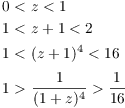
In general, to estimate the z-term you'd have to find the absolute max on the interval for z. If you know that the z-term is either increasing or decreasing, you can check its value at the interval endpoints, and take the largest.
Using the estimates for ![]() and
and
![]() , I have
, I have
![]()
The error is no greater than ![]() .
.
I can check this by plotting the difference between the ![]() degree Taylor polynomial and
degree Taylor polynomial and ![]() .
.
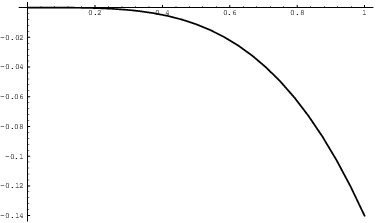
From the picture, it looks as though the maximum error is around 0.15
(in absolute value). The estimated error was pretty conservative.![]()
Example. (a) Compute ![]() for
for ![]() , and express
, and express
![]() using
using ![]() and the remainder term.
and the remainder term.
(b) Use ![]() to approximate the largest error that
occurs in using
to approximate the largest error that
occurs in using ![]() to approximate
to approximate ![]() for
for ![]() .
.
(a) Since I want ![]() , I need the fourth derivative:
, I need the fourth derivative:
![]()
Thus,
![]()
Now

Therefore,
![]()
Here z is between 0 and x.![]()
(b) I have
![]()
I'll estimate the z and x-terms one at a time.
Since ![]() , I have
, I have
![]()
Since ![]() and z is between 0 and x, it follows that
and z is between 0 and x, it follows that
![]() . On this interval,
. On this interval, ![]() decreases, so it attains its largest value
at
decreases, so it attains its largest value
at ![]() . Therefore,
. Therefore,
![]()
Alternatively,
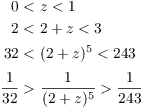
Thus,
![]()
The error is no greater than ![]() .
.![]()
Example. Find the smallest value of n for
which the ![]() degree Taylor series for
degree Taylor series for ![]() at
at ![]() approximates
approximates ![]() on the interval
on the interval ![]() with an
error no greater than
with an
error no greater than ![]() .
.
Notice that
![]()
So
![]()
First, I'll estimate how large the z and x-terms can be. Since ![]() and
and ![]() is an increasing function, I have
is an increasing function, I have
![]()
Since ![]() and since
and since ![]() is an increasing function, I have
is an increasing function, I have
![]()
Thus,
![]()
Therefore, I want the smallest n for which
![]()
I can't solve this inequality algebraically, so I'll have to use trial-and-error:
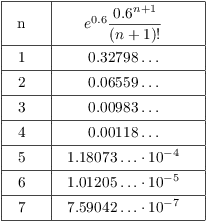
The smallest value of n is ![]() .
.![]()
You can also use the Remainder Term to estimate the error in using a Taylor polynomial to approximate an integral.
Example. Calvin wants to impress Phoebe Small
by using the MacLaurin series for ![]() to approximate
to approximate
![]() to within 0.0001.
How many terms of the series should he use?
to within 0.0001.
How many terms of the series should he use?
The Maclaurin series for ![]() is
is
![]()
(Substitute ![]() in the standard series for
in the standard series for ![]() .) I want to know how many terms of the series to use
to approximate the integral.
.) I want to know how many terms of the series to use
to approximate the integral.
Since ![]() , I have
, I have
![]()
Therefore,
![]()
In the integral, x goes from 0 to 0.5, and z is a number between 0
(the expansion point) and x. Therefore, I know that z is a number
between 0 and 0.5. Taking the worst possible case, the largest ![]() could be is
could be is ![]() .
Replace
.
Replace ![]() with e to obtain
with e to obtain
![]()
Insert this into the integral (remembering to multiply by x):
![]()
I want the smallest value of n for which this ugly mess is less than 0.0001. The easiest way to do this is by trial: Plug in successive values of n.
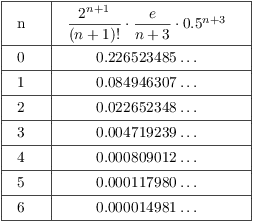
![]() is the smallest value that works.
is the smallest value that works.![]()
Copyright 2020 by Bruce Ikenaga